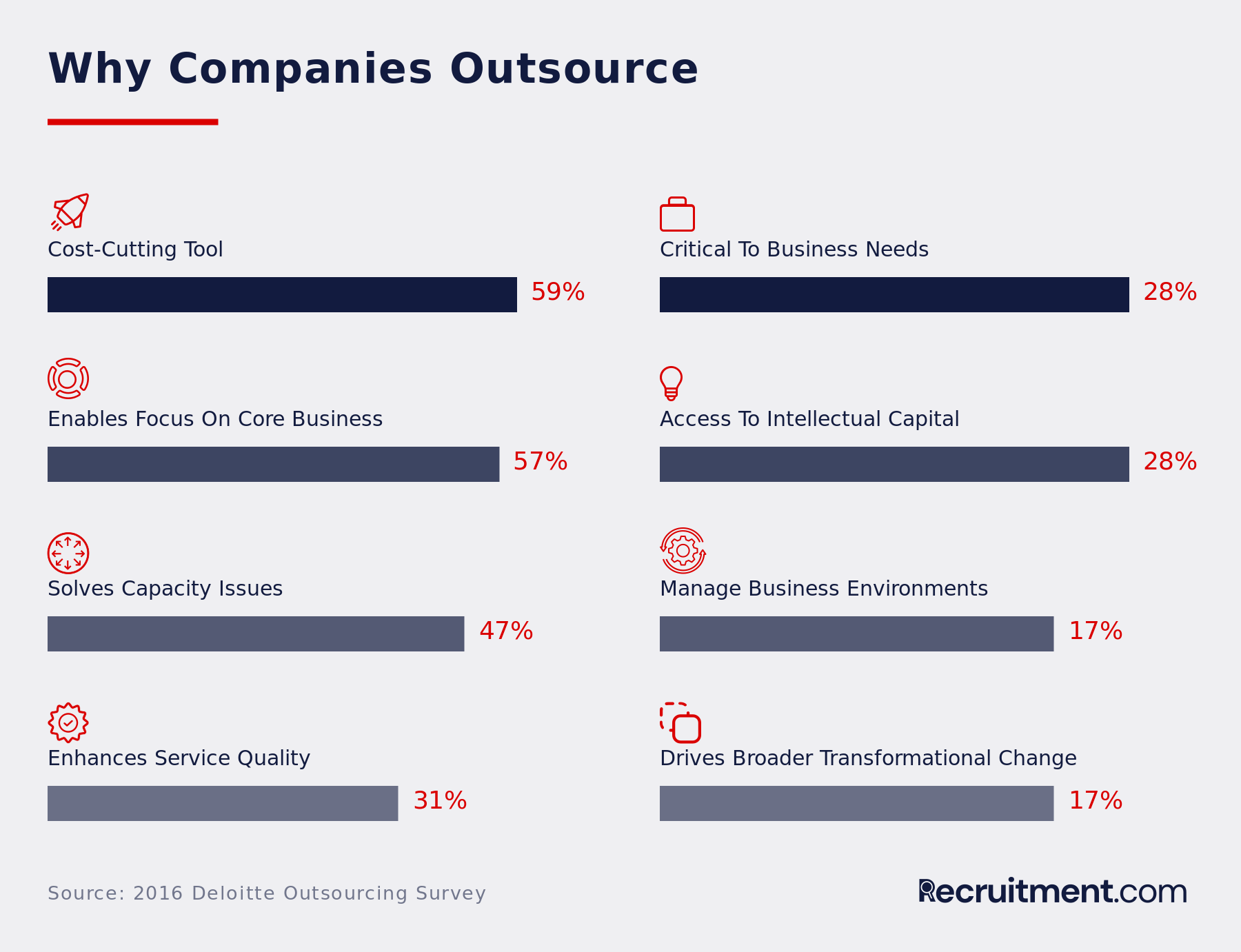What Does Outsourcing Look Like Today?

Dann Albright is a writer and researcher specializing in human resources and finance.
Many companies outsource their IT services to overseas contractors to reduce costs. Some outsource temporary help as in the staff augmentation model. And remote contracting is common in many fields.
Outsourcing has been a proven way to lower costs. Its imprint is only going to get bigger—by 2025, it will likely be a $343 billion market. There's no question that outsourcing and contracting are becoming more popular among companies.
But there are still many important questions about outsourcing left to answer.
- Is it a good business practice?
- Does it drive industry-leading results?
- What's the best way to partner with outsourcing providers in a way that doesn't result in poor business outcomes?
To find the answers, we gathered insights from some of the most respected names in the business and consulting worlds. Together, they show an interesting picture of outsourcing that has evolved from what it was even a few years ago.
Before we look at where outsourcing is today and where it's headed tomorrow, though, let's get clear on some terms.

What Is Outsourcing?
Outsourcing is the practice of hiring a third party to complete a task or business process for your company. It might be a single person on a short-term basis or an entire company with a years-long contract. The crucial part is that it's an outside firm and that it completes tasks that could be completed in house.
Some companies outsource tasks that they don't want to hire for or are time-consuming. You might outsource HR if you don't have very many employees and hiring a full-time HR person wouldn't be efficient, for example. Others outsource when they need help on a project, such as back-office functionality. They might bring in people with specific skill sets or just "more hands on deck" to hit a deadline.
It's important to note that outsourcing is different from some similar practices:
- Offshoring: Moving part of a workforce overseas. This might involve hiring new full-time employees in a developing country, moving some of an existing workforce to another location, or hiring contractors from cheaper places.
- Staff augmentation: Hiring one or more contractors to supplement an internal team. This differs from outsourcing in that outsourcing usually involves hiring a team to take over an entire task or project, not just supplement internal staff.
- Distributed work: A distributed company lets employees work remotely. These companies might outsource some functions, but they also have a wider range of options for full hires.
Why The World's Most Successful Companies Are Outsourcing
Many highly successful companies use outsourced services for a variety of reasons. Toyota North America, Cisco, Boeing, Dell, Ford, Enron, RBS, and other multinational organizations outsource important parts of their businesses.
And while companies outsource for a wide variety of reasons, there are some notable patterns. Reasons that companies reported outsourcing in Deloitte's 2016 Global Outsourcing Survey included cost savings, to focus on their core business, and to help with capacity issues.

Cutting costs, enabling a focus on core competencies, and solving capacity issues all point to the same idea: that companies aren't able to do everything they want to do with their current financial and human resources.
Interestingly, both access to intellectual capital and driving transformational change are low on the list. But that could be changing.
Ning Su, Natalia Levina, and Jeanne W. Ross, writing for MIT's Sloan Management Review, point out that "today, more than ever, as rapid technological changes disrupt industries, established companies need access to fresh ideas, new technologies, and cutting-edge expertise."
In short, companies are now outsourcing not just for help on projects, but also to drive innovation as a competitive advantage.
"Innovation" is a word that comes up a lot in discussions of modern outsourcing.
If companies don't innovate, they fall behind. From product design to hiring practices, companies need to create positive change if they're to continue competing with industry peers. But innovation is expensive and requires a huge amount of financial and human capital. That's where outsourcing comes in.
Strategically outsourcing innovation can result in up to a 90% drop in both the costs and risks of innovation. So organizations can continue to improve and get a leg up on their competitors without the hefty costs of doing it in-house.
Which Functions Do Companies Outsource For Innovation?
When you think of innovation in the business world, you probably think of strategy or product decisions. But that's not where companies are spending their outsourcing dollars.
Many companies utilize business process outsourcing for IT work: server maintenance, help desk staffing, network management, and so on. But the most common types of IT tasks to outsource are ones where innovation is crucial: application development tops the list at 64%. And applications can drive a huge amount of innovation.
The key point here is that outsourcing is no longer just a cost-saving measure. Cost is still a big factor. But companies are moving to a relationship-based model with their outsourcing providers that involve closer contact with vendors. Some organizations are even assigning internal staff to manage outsourcing relationships to foster innovation.
To see a great example of a modern outsourcing arrangement, check out how Vodafone Spain turned around its abysmal customer service reputation by not just hiring, but partnering with, contractors.
Balancing The Drawbacks Of Business Process Outsourcing
Of course, there are also drawbacks to outsourcing business functions. Deloitte found that many companies have concerns with data security/information technology, loss of intellectual property, compliance, and other serious issues.
There are also some concerns that outsourcing could actually decrease innovation. Giving up control can result in quality control issues. Terminating a contract can come with significant penalties.
And there's the fact that over a long period, outsourcing can actually cost more than hiring in-house services. Those labor costs may be offset by higher performance, but spending the time and money to hire full-time employees may provide better value in the long run.
Even with these drawbacks, however, it's clear that the benefits of outsourcing are often worth the trade—which is why some of the most successful companies in the world continue to outsource significant amounts of work every year.
Outsourcing Can Offer World-Class Capabilities
While innovation is a worthy goal, many companies outsource for a more mundane reason: to address deficiencies.
In a rapidly changing technological environment, organizations need to have access to a highly educated, skilled workforce. And keeping that workforce on staff doesn't always make sense. Outsourcing projects means companies can always hire contractors with the latest skills.
Outsourcing software development and IT work can be one of the benefits of outsourcing: keeping up with the demands of modern software and hardware is expensive, but outsourcing IT services can help defray the cost. Outsourcing companies update their own software and hardware, letting companies (especially small businesses) take advantage without significant expenditure.
And, as we saw earlier, sometimes organizations just don't have the staff to handle a new project. Outsourcing and business process outsourcing solves this capacity problem.
How To Get The Most From Modern Outsourcing
Outsourcing has changed the way that companies operate—as well as the pace at which they innovate. But what does the future hold for outsourcing and outsourcing services? And how can your company keep pace with its rapid changes?
One of the components that thought leaders consistently emphasize is automation. As Deloitte says in its report on robotic process automation (RPA), "RPA is here to stay, and will likely be the driving force in outsourcing in the years to come." Outsourcing providers will be expected to implement or even build new automated workflows to help companies run more efficiently and expand on their core competencies. Independent contractors may be replaced by algorithms, with people only stepping in to manage exceptions and troubleshoot problems in the workflows.
KPMG also predicts that outsourcing will grow out of its current focus on cost savings. Instead of simply helping companies boost their bottom line, outsourcing service providers can offer added value and even get paid based on the results they deliver. Profit-sharing and value-driven pricing will become the norm as low-cost outsourcing becomes passé.
Both of these outsourcing trends point toward another change in the current model: an emphasis on relationships. You'll need someone to not only implement RPA, but to maintain and update the systems put in place. Contractors who get paid based on delivering results will want more detailed insights into your company and how they fit into your strategic plans.
Su, Levina, and Ross highlight this change by presenting a new strategy for creating a "supplier portfolio":
“This innovative IT-outsourcing model combines a few key partnerships with a dynamically changing and unrestricted number of smaller contracts with other suppliers to deliver specific value propositions beyond the capabilities of the key partners. Representing a dynamic, diversified, and yet disciplined approach toward outsourcing, the long-tail strategy embraces and even fosters a flow of new suppliers offering new capabilities that can enable the company to prosper in turbulent business environments. . . . If orchestrated effectively, this strategy can turn into a reality the seemingly unattainable twin goals of introducing innovation while ensuring cost and efficiency.”
Whether companies adopt this model or not, they'll have to come to terms with the fact that outsourcing is no longer just hiring a third party to complete a project that the staff doesn't have time for. It now involves building long-term outsourcing relationships while still taking advantage of fast turnaround times and innovative new players.
Before doing any of this, however, companies need to undergo a shift in their perceptions of outsourcing.
Conclusion: Outsourcing Can Be A Competitive Advantage
We set out to answer a question with this article: "What does outsourcing look like today?" Interestingly enough, we came up with a counterintuitive answer: it looks less and less like outsourcing. It looks more like partnering, and in some cases, even in-house hiring.
But every company has its own outsourcing methods and practices. None of these points apply to every company. And sometimes the best way to learn is to hear from commentators on the ground that outsource projects and work with contractors every day.
- How does your company use outsourcing to deliver results?
- Are you seeing these changes, or are you still in the single-project-outsourcing model?

Dann Albright is a writer and researcher specializing in human resources and finance.





